Nothing is more exciting than spotting an owl in your backyard if you live in Alaska. These magnificent birds of prey are a beautiful sight to behold. If you’re an avid birdwatcher, you’re probably eager to identify which types of owls are visiting your property.
There are 10 owl species found in Alaska, including the Northern Hawk-Owl, Boreal Owl, Western Screech-Owl, Snowy Owl, Great Horned Owl, Barred Owl, Short-eared Owl, Northern Saw-whet Owl, Northern Pygmy-Owl, and Great Gray Owl. While several of these owl species have their preferred mating and migratory ranges, it’s possible to spot a vagrant or irrupting owl in areas outside their known territories. If you see an owl in Alaska that is not on this list, consider yourself lucky!
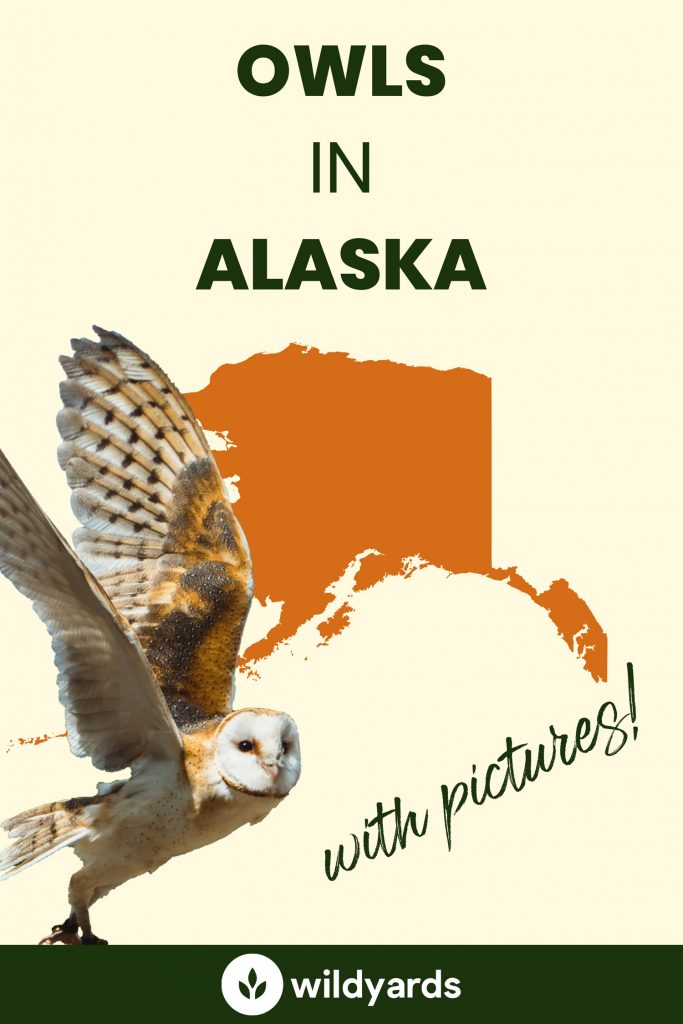
The legend below can be used to help you determine where each of the 10 owls of Alaska lives during different parts of the year.
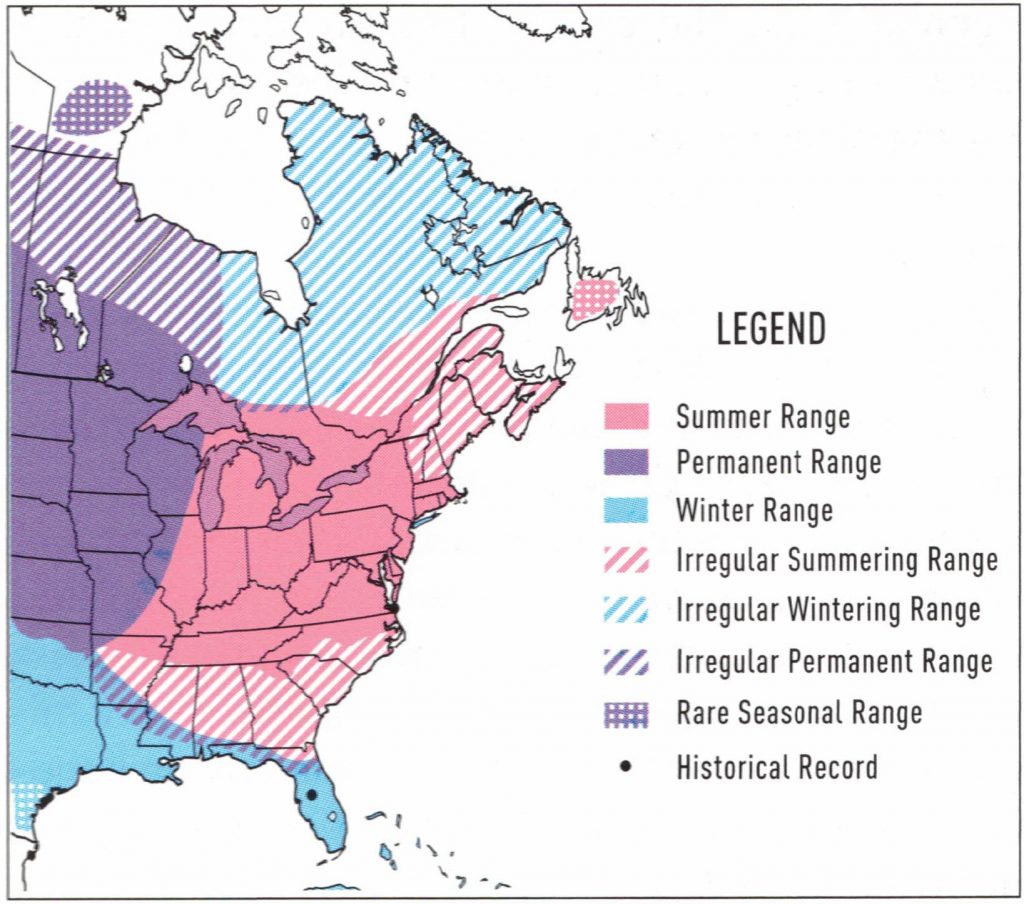
The 10 Species of Owls in Alaska
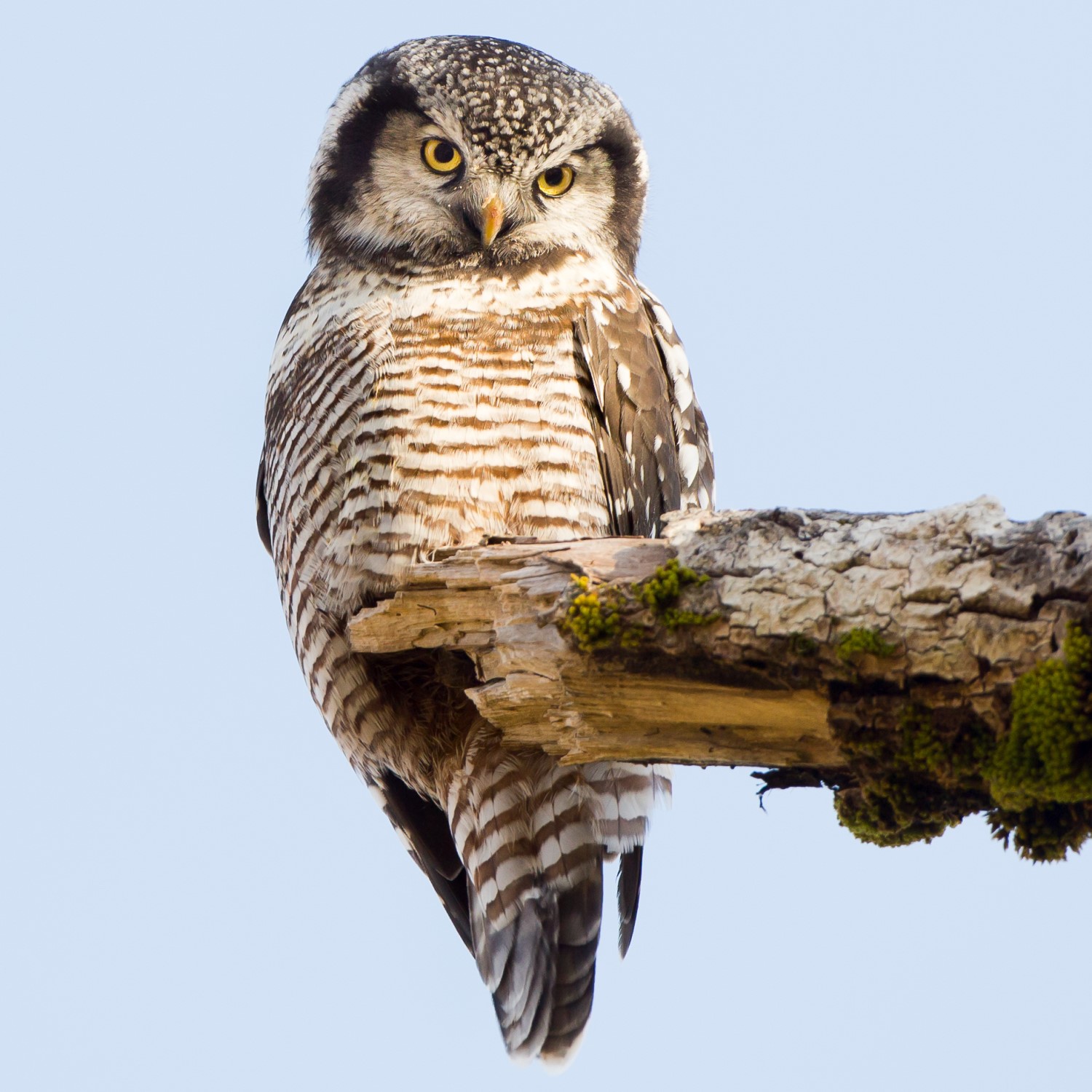
Northern Hawk Owl
Surnia ulula
Order: Strigiformes
Family: Strigidae
Size: 13.5-17.5 in. (33.5-44.4 cm)
Overview
As birds of prey, owls must rely on all of their senses to close in on a kill. But the northern hawk owl prefers to hunt by sight and can spot its prey from an amazing distance of half a mile away. These owls have poorer hearing than most others because their ear openings are not asymmetrical. Still, they can track small mammals beneath a foot of snow if need be. As their name implies, the northern hawk owl prefers to stick to the northernmost portion of North America, but stragglers have been known to find their way south as food becomes scarce. Northern hawk owls nest in dead trees and hollow stumps, where they raise clutches of 3 to 11 eggs at a time. Fearless and confrontational, northern hawk owls will attack anything that wanders too close to their nesting sites, whether it’s a squirrel or a human.
How to Identify
Hawk owls look like owls, but act like hawks, perching in treetops and searching for their prey right out in the open during the daylight hours. These owls are characterized by long tails and small round heads surrounded by a border of dark brown feathers. Their vibrant yellow eyes and beaks stand in stark contrast to their red-brown feathers. Northern hawk owls have nearly solid brown backs and striped fronts and use shrill rolling whistles to attract potential mates.
Northern Hawk Owl Range & Migration Map
These magnificent birds do not live in the United States year-round, but they do like to spend their winters here. You can find the northern hawk owl in the forests of the northernmost states, including New Hampshire, Vermont, and New York all the way to the west, in Washington, Idaho, and Montana.
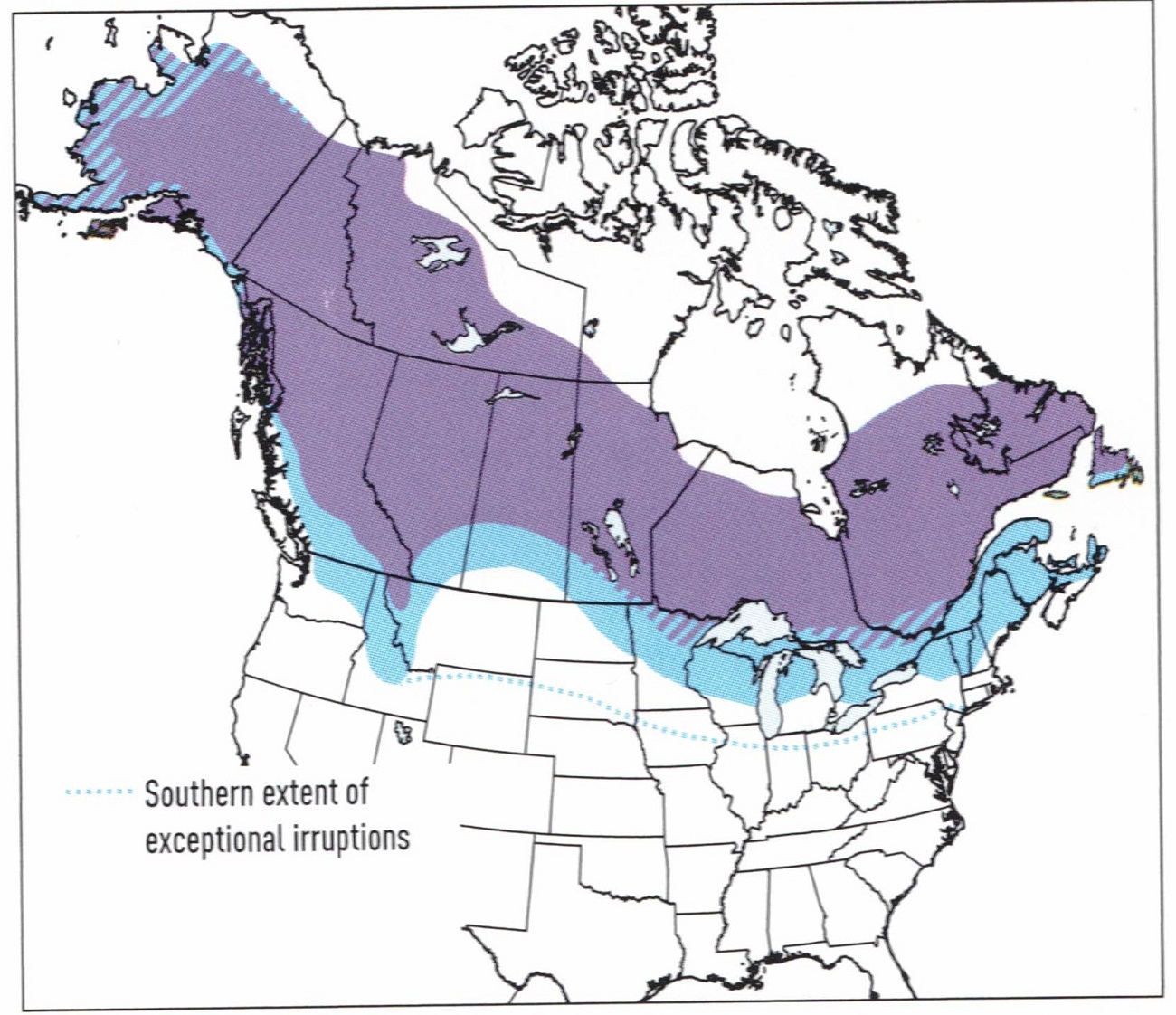
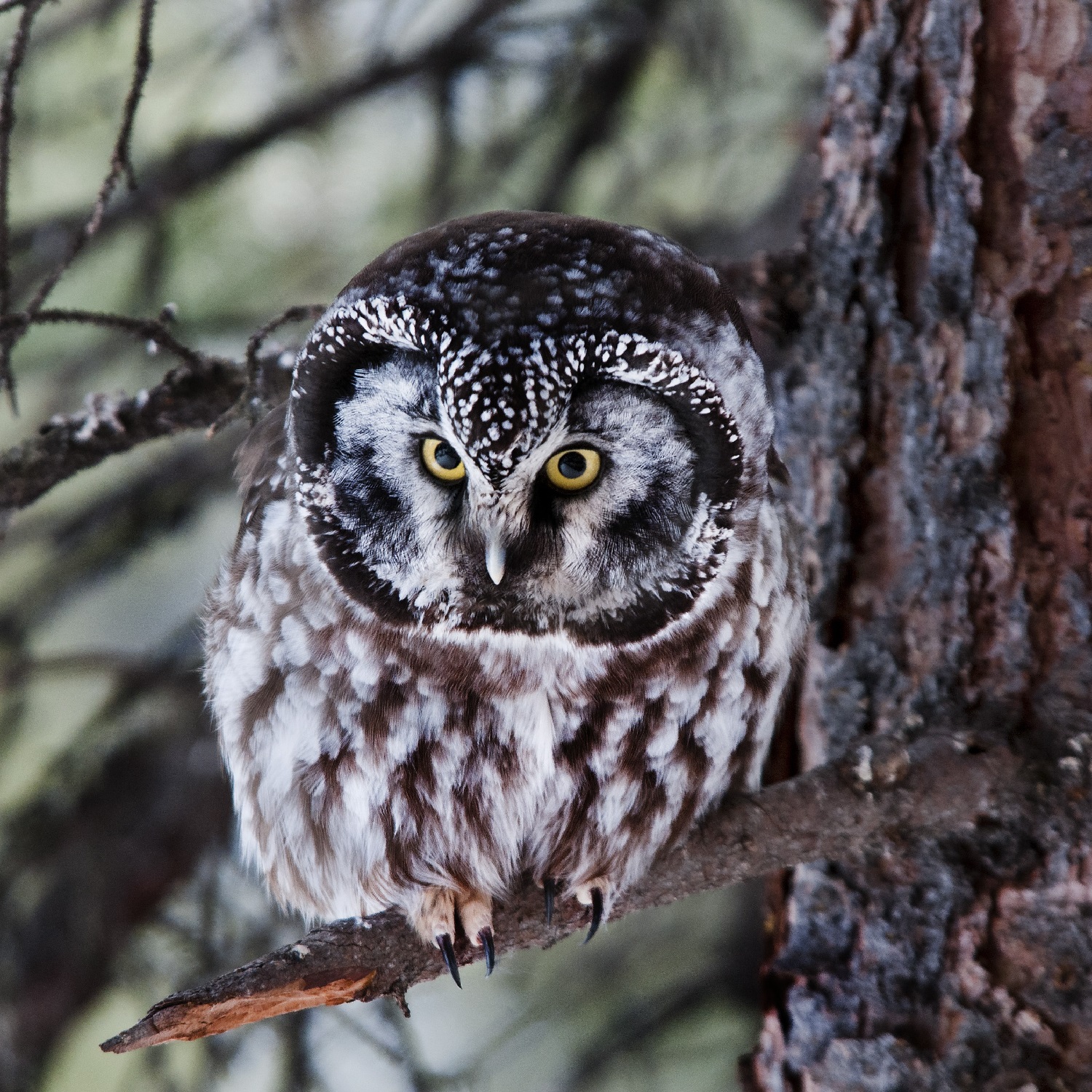
Boreal Owl
Aegolius funereus
Order: Strigiformes
Family: Strigidae
Size: 9-10 in. (22.9-25.5 cm)
Overview
Small and elusive, boreal owls show the most sexual dimorphism of any other owl, with females growing twice as large as the males of the species. Boreal owls are difficult to track down because they roost in different trees every day. They’re also quiet, although males will begin hooting at night in the late winter and spring in order to attract a mate. Boreal owls are very small, about the size of a robin or blue jay. Like most other owls, their skulls are asymmetrical, with one ear opening perched higher than the other. This unique design enables boreal owls to accurately judge both height and distance when closing in on their prey.
How to Identify
With their round faces and red-brown feathers, boreal owls resemble barred owls, although they’re much smaller. These owls have large bright yellow eyes, giving them a surprised expression. As their name suggests, boreal owls prefer to reside in boreal forests full of spruce, pine, and fir trees. Boreal owls are most active at night when they track down small mammals and insects.
Boreal Owl Range & Migration Map
You can find boreal owls in Washington, Idaho, and Montana, though their range goes as far south as the northernmost region of New Mexico. Boreal owls love to perch in conifer and evergreen trees. Deforestation has led to a decline in habitat for these shy owls. But, while they can be tough to find, they have been known to use nesting boxes, so installing a few on your property can greatly increase your chances of spotting one.
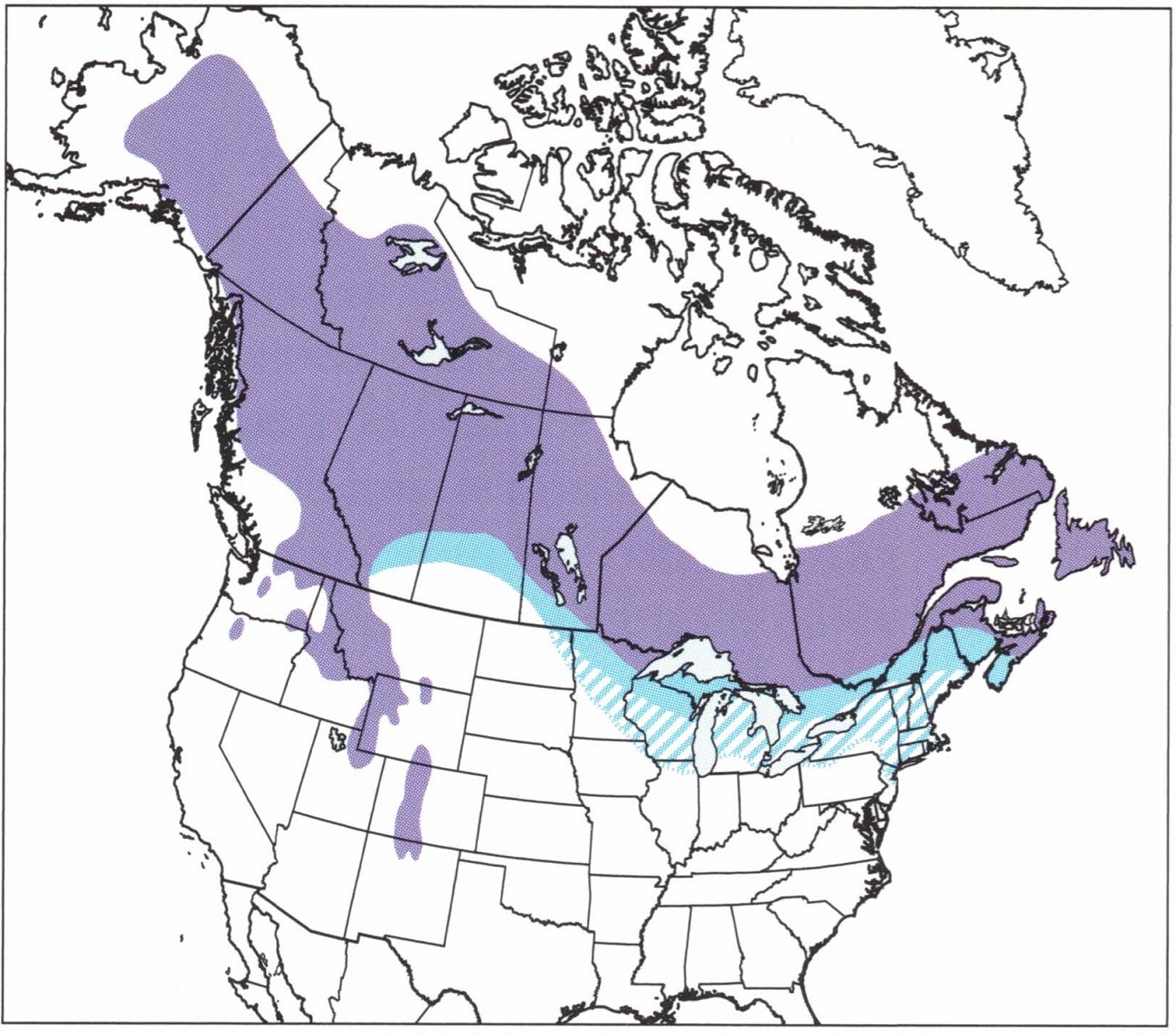
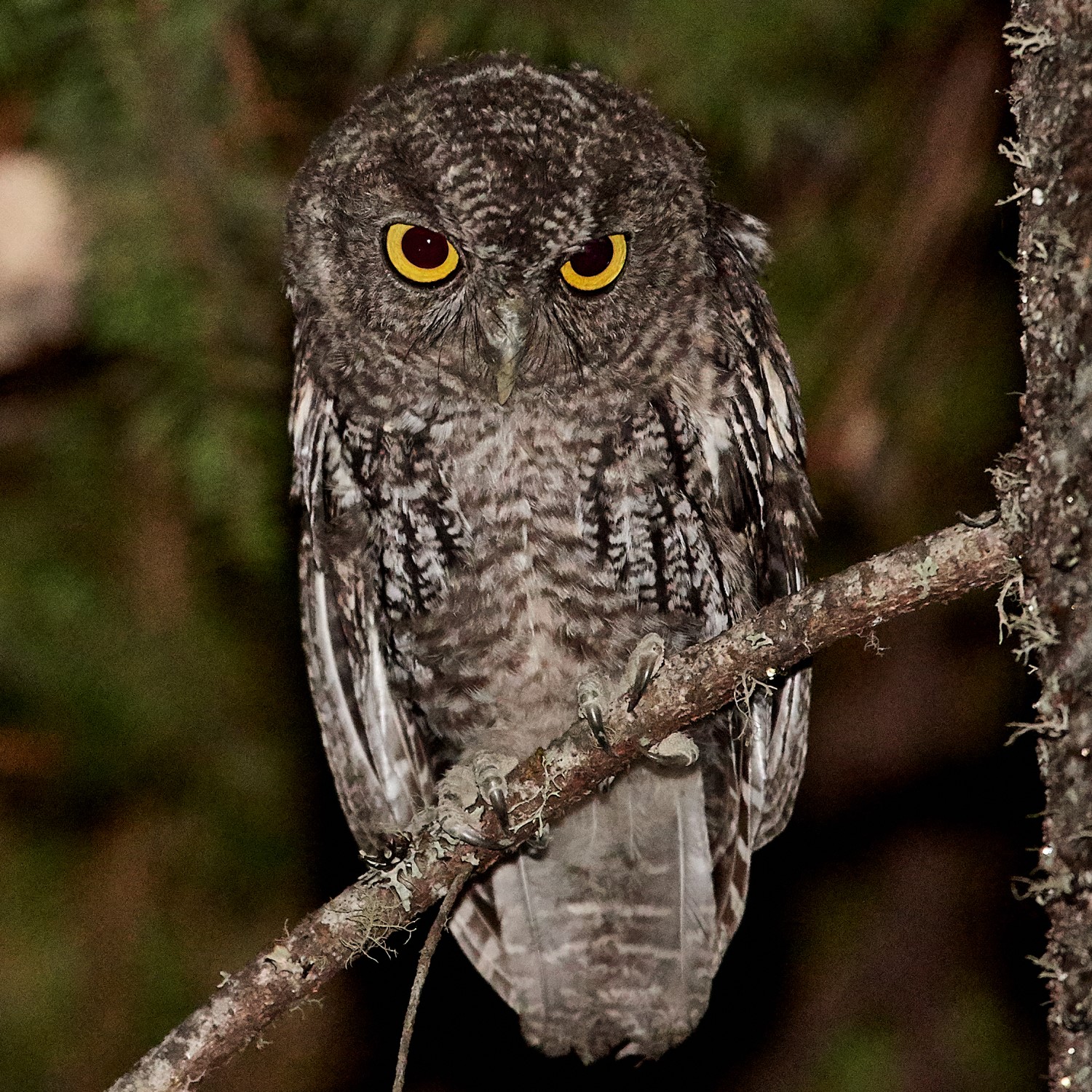
Western Screech-Owl
Megascops kennicottii
Order: Strigiformes
Family: Strigidae
Size: 7.5-9.5 in. (19-24 cm)
Overview
These are small owls, maxing out at just 9 inches in length and with wingspans of roughly 24 inches. But, don’t let their small stature deceive you. These birds are serious predators, regularly seeking out prey many times their own size. While western screech-owls feed on rodents, small birds, earthworms, and other bugs, they’ve also been seen preying on rabbits. Western screech-owls like to sit close to where limbs meet the tree trunk, so they can huddle up against them in order to camouflage themselves from predators and prey. These are opportunistic predators who like an easy meal, but, when determined, they will also chase their prey down, sometimes grabbing birds and insects midflight.
How to Identify
Western screech-owls look much like eastern screech-owls, with adult morphs in Great Plains, Mexican, Mojave, brown Pacific, and gray Pacific colorations. They have gray and brown plumage with no hint of red. Western screech-owls have small, round heads with ear tufts and vivid yellow eyes. Contrary to what their name would lead you to believe, western screech-owls usually don’t screech. Instead, they use short whistles and trills to communicate with each other.
Western Screech-Owl Range & Migration Map
These owls are highly adaptable, making their homes in a variety of regions, including deserts, grasslands, forests, and urban areas. You can find western screech-owls all across the west coast, drifting inward a bit to Idaho, Wyoming, Utah, Colorado, New Mexico, and parts of Texas. If you live in one of these regions, try installing a nesting box to attract a western screech-owl to your backyard.
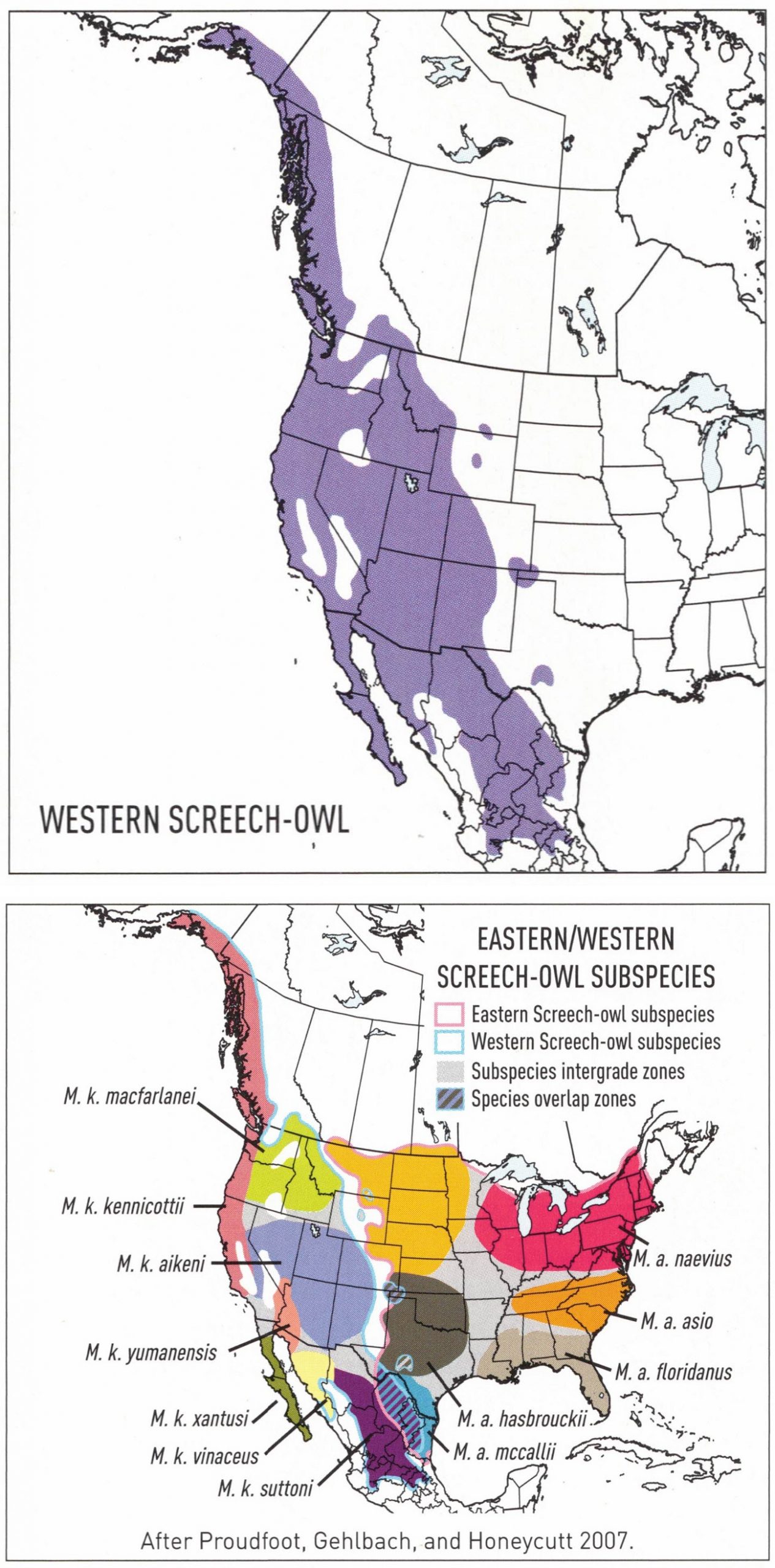

Snowy Owl
Bubo scandiacus
Order: Strigiformes
Family: Strigidae
Size: 20.5-27.9 in. (52-71 cm)
Overview
Snowy owls are the heaviest owls, with adults averaging between 3 and 5 pounds. Their dense plumage makes them weightier, but it also allows them to withstand the cold temperatures of the Arctic tundra. These are powerful birds at roughly 28 inches long with a wingspan of 57 inches. They’re aggressive, too, using their sharp talons and strong feet to defend their territories from predators and competitors. These owls hunt almost exclusively during the daytime and can eat more than 1,600 lemmings in a year. Their voracious appetites can have a devastating impact on their food supply, but these skilled fliers are willing and able to fly south in search of prey. Snowy owl populations have declined 64% since 1970 due to illegal hunting and vehicle collisions, as well as climate change.
How to Identify
Juveniles of the species have brown and black markings over a base of white plumage. As these birds age, they lose most of their markings. At maturity, males will be almost pure white, with females retaining some of their patternings. These owls have hoarse voices and use a variety of calls, the most frequent of which is a rhythmic “krooh-krooh-krooh-krooh”.
Snowy Owl Range & Migration Map
Snowy owls don’t live in the United States all year long, however, they do winter in the northern states. You can see snowy owls from Washington all the way across to Maine. In years when their preferred prey was especially limited, snowy owls were sighted as far south as Florida, so it’s possible to spot one of these beauties no matter where you are in the U.S.
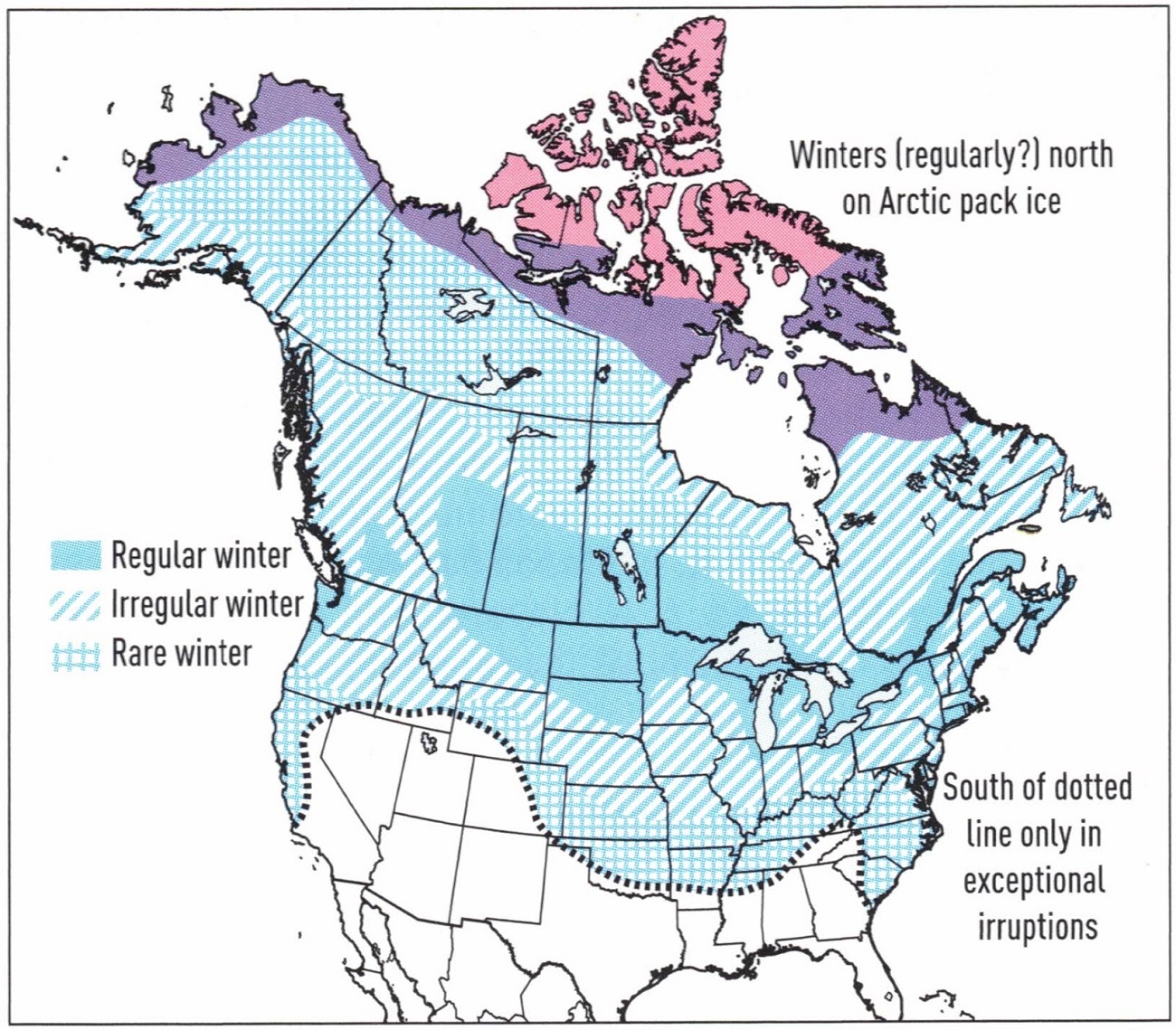

Great Horned Owl
Bubo virginianus
Order: Strigiformes
Family: Strigidae
Size: 18-26 in. (46-63 cm)
Overview
Far from meek, Great Horned owls have been known to hunt other birds of prey, including ospreys, peregrines, and even other owls. With their strong talons, these birds can exert 28-pounds of force allowing them to tackle larger prey. Great orned owls are a major threat to other birds, especially jays and crows. In fact, if you ever hear a large group of these birds making a fuss, there’s a good chance it’s because a great horned owl has gotten too close to their nests. The great horned owl’s plumage is ultra-soft, and this provides the animals with several benefits. For starters, it protects them from the harsh cold. But it also muffles sound, allowing them to fly silently as they swoop down on their prey. Interestingly, although the females of the species are larger than the males, females have higher-pitched voices, and mated pairs often synchronize their calls.
How to Identify
The great horned owl is easily identified by a matching pair of tufts on either side of its head, giving it a horned appearance. They have gray to red-brown barred plumage and golden yellow eyes that do not move within the sockets. These birds can rotate their heads 180 degrees to see and hear what’s going on around them. Facial feather discs help direct soundwaves to their ears, allowing them to track their prey, and their wide wings enable them to fly deftly, with serrated primary feathers dispersing turbulence and softer feathers muffling sound.
Great Horned Owl Range & Migration Map
These magnificent owls can be found in every state in the nation except Hawaii. These owls are native to the Americas, and they’re highly adaptable, dwelling in forested, rural, and urban areas alike. While you’re liable to see a great horned owl just about anywhere, keep your eyes peeled near wooded areas, especially along treelines as these birds like to perch near open fields to find their prey.
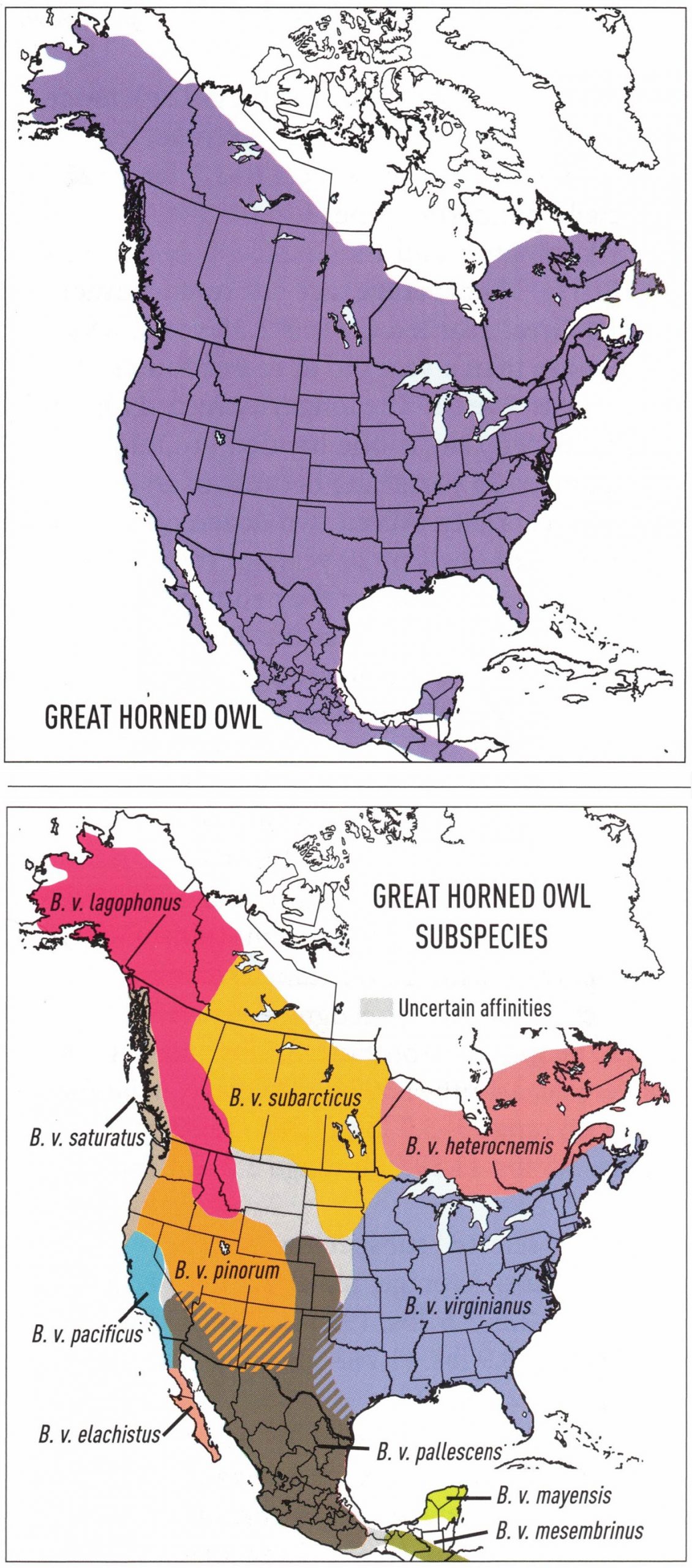
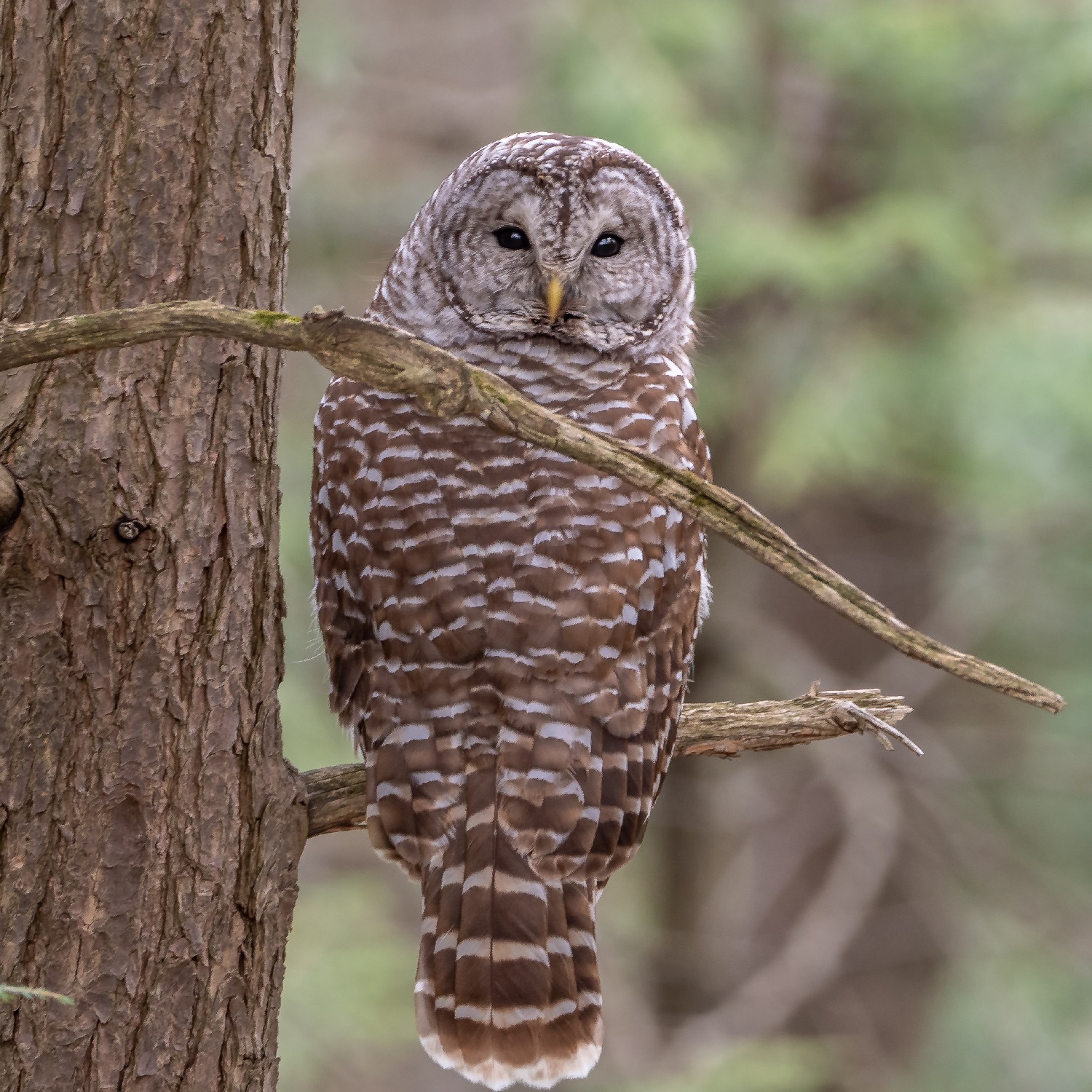
Barred Owl
Strix varia
Order: Strigiformes
Family: Strigidae
Size: 19-22 in. (48.25-56 cm)
Overview
Masters of camouflage, barred owls can be tough to spot. Fortunately, their loud hooting calls “Who cooks for you? Who cooks for you all?” are easy to hear. Barred owls prefer to dwell in forests where they can track down rabbits, squirrels, and even raccoons. These owls saw a serious population boom in the 20th century, expanding their range to include forestland in the western states. Barred owls tend to stay close to home throughout their lives, often only traveling around a 6-mile radius. Like barn owls, barred owls are monogamous and do most of their hunting at night.
How to Identify
With their deep brown eyes and gentle round faces, barred owls look exactly as you would expect owls to look. These birds are covered in red-brown feathers with white horizontal stripes or bars. Barred owls are most commonly spotted on the edges of forests at dusk, where they can easily locate their prey.
Barred Owl Range & Migration Map
Once relegated to southeastern Canada and New England, the barred owl expanded westward. These owls can now be found in parts of Minnesota, Nebraska, Kansas, and Oklahoma. Barred owls have become quite adaptable, and can be spotted in urban areas as well as rural regions. These birds are extremely territorial, with mated pairs getting into hooting matches with outsiders in order to defend their homes.
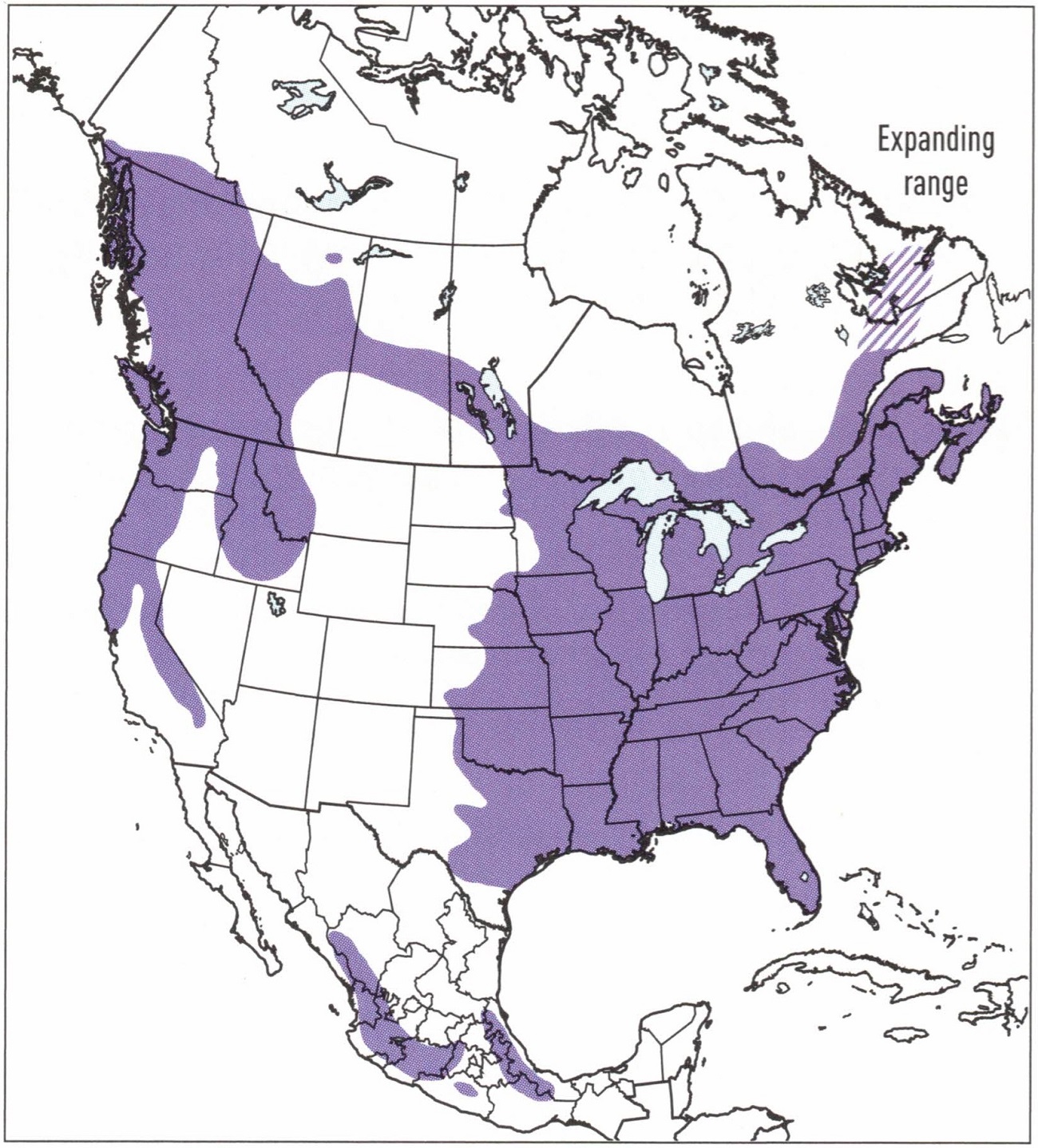
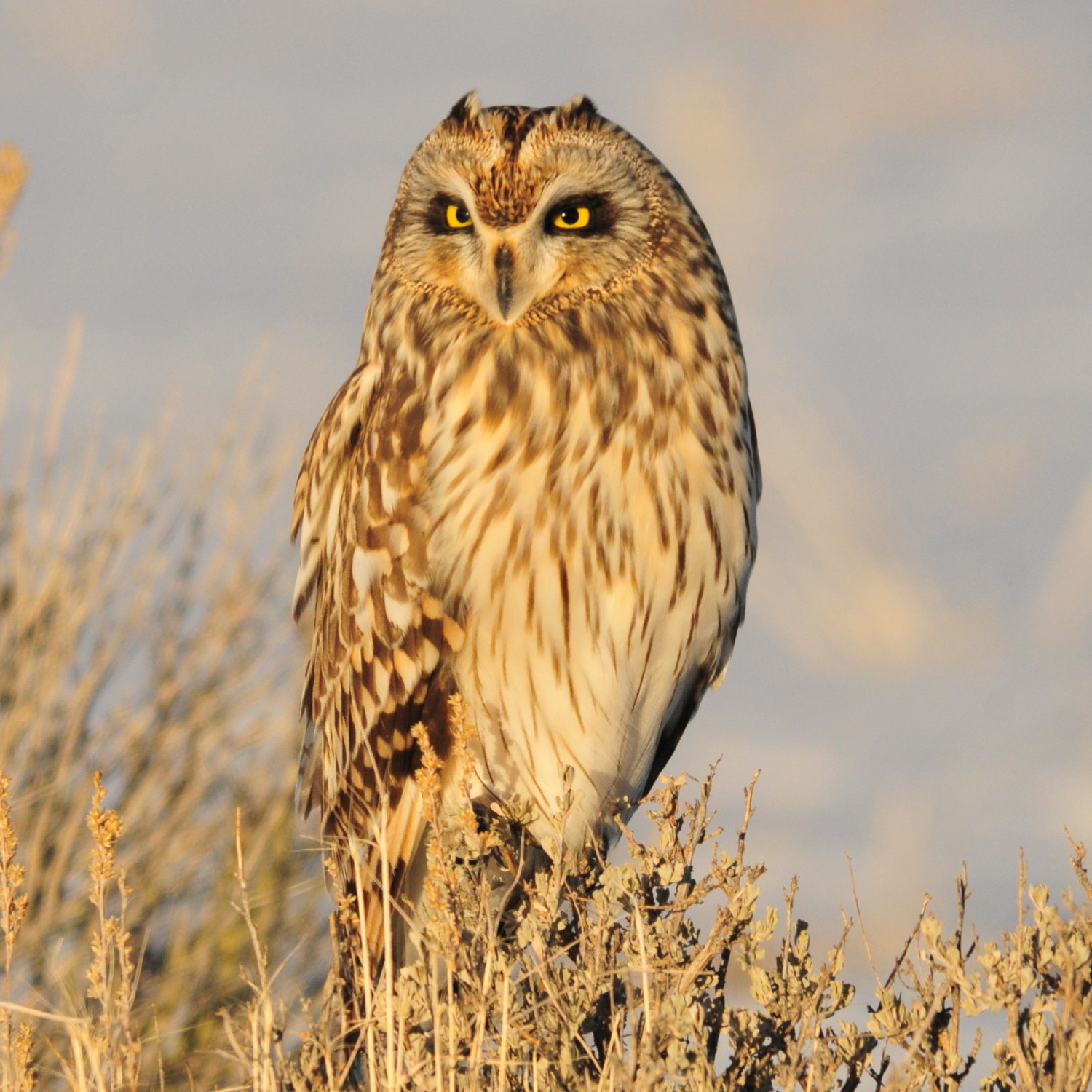
Short-eared Owl
Asio flammeus
Order: Strigiformes
Family: Strigidae
Size: 14.5-15 in. (37-38 cm)
Overview
A classic birdwatcher favorite, short-eared owls hunt during the daytime and can be found throughout the United States. These owls are some of the few that prefer to build their own nests. Females construct their bowl-shaped nests in the ground, lining them with feathers, grasses, and other soft materials before laying clutches of 4 to 7 eggs. Short-eared owls have very distinctive flight patterns, with irregular wingbeats similar to that of bats or moths. These birds are typically 17 inches in length and have wingspans of up to 43 inches. They use their powerful wings to stay upright as they swoop feet-first to capture their prey, which consists of small mammals, rodents, reptiles, and amphibians. Short-eared owls sometimes dine on songbirds and will tear the wings off before swallowing them whole.
How to Identify
The ear tufts of the short-eared owl are situated towards the center of their heads, and they’re so short that sometimes they may not be visible at all. Short-eared owls have tawny plumage on their backs and wings with tan bellies that are interspersed with vertical dark brown streaks. Tailfeathers are barred. These owls have small, round faces with pale tan to creamy white facial disks accented by black-brimmed yellow eyes. Short-eared owls use sharp “waowk-waowk-waowk” calls to communicate and “eeee-yerp” cries during the mating season.
Short-eared Owl Range & Migration Map
Excellent long-distance fliers, short-eared owls have been reported landing on watercraft hundreds of miles from shore. These birds will fly over the ocean and land to reach their breeding grounds in northern Canada. You can find short-eared owls living year-round in the north and northwest portions of the United States. But, because they travel regularly, you can spot stragglers in nearly every state in the nation. These birds prefer to dwell in open areas, including grasslands, marshes, and farmland.
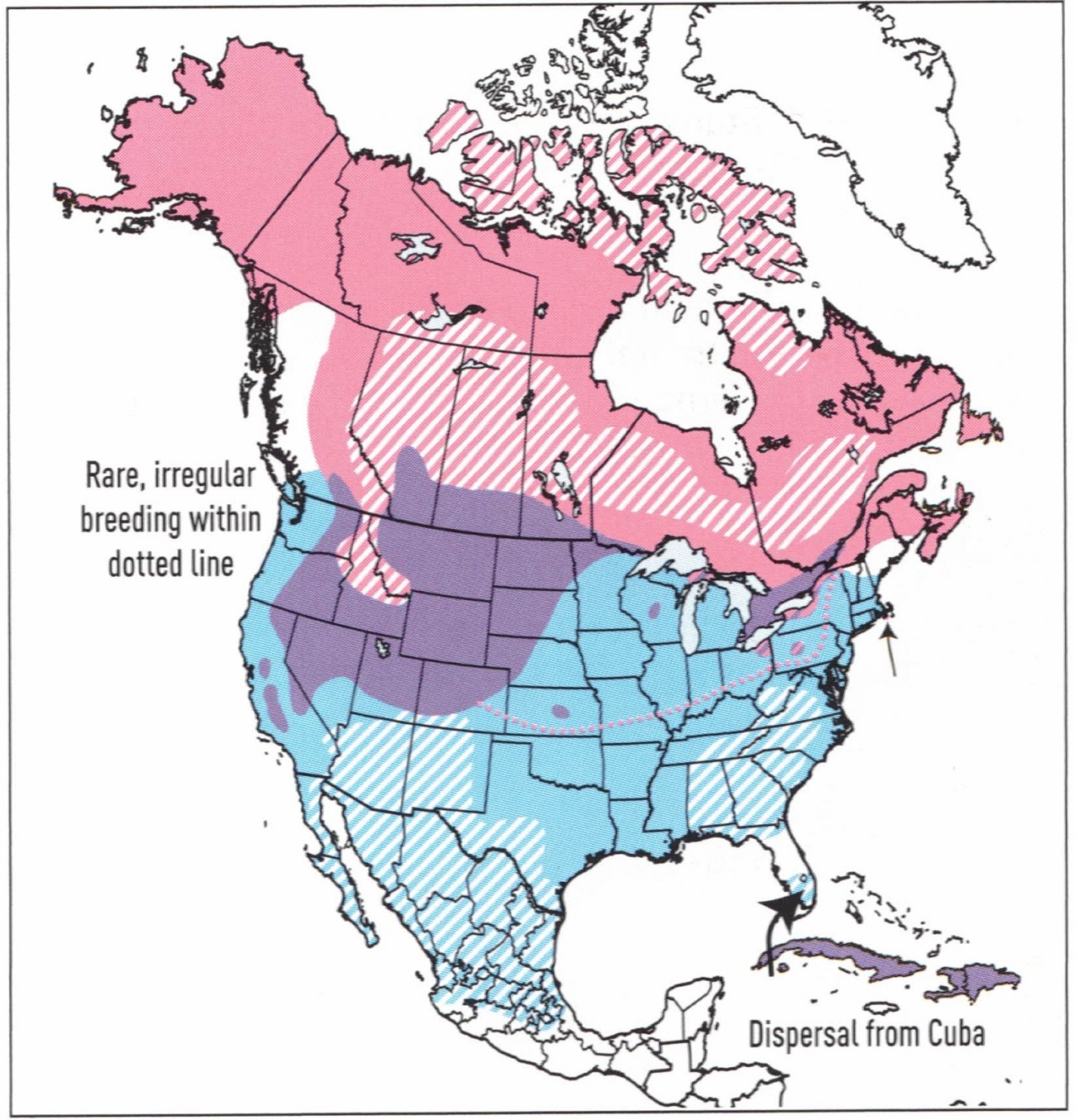
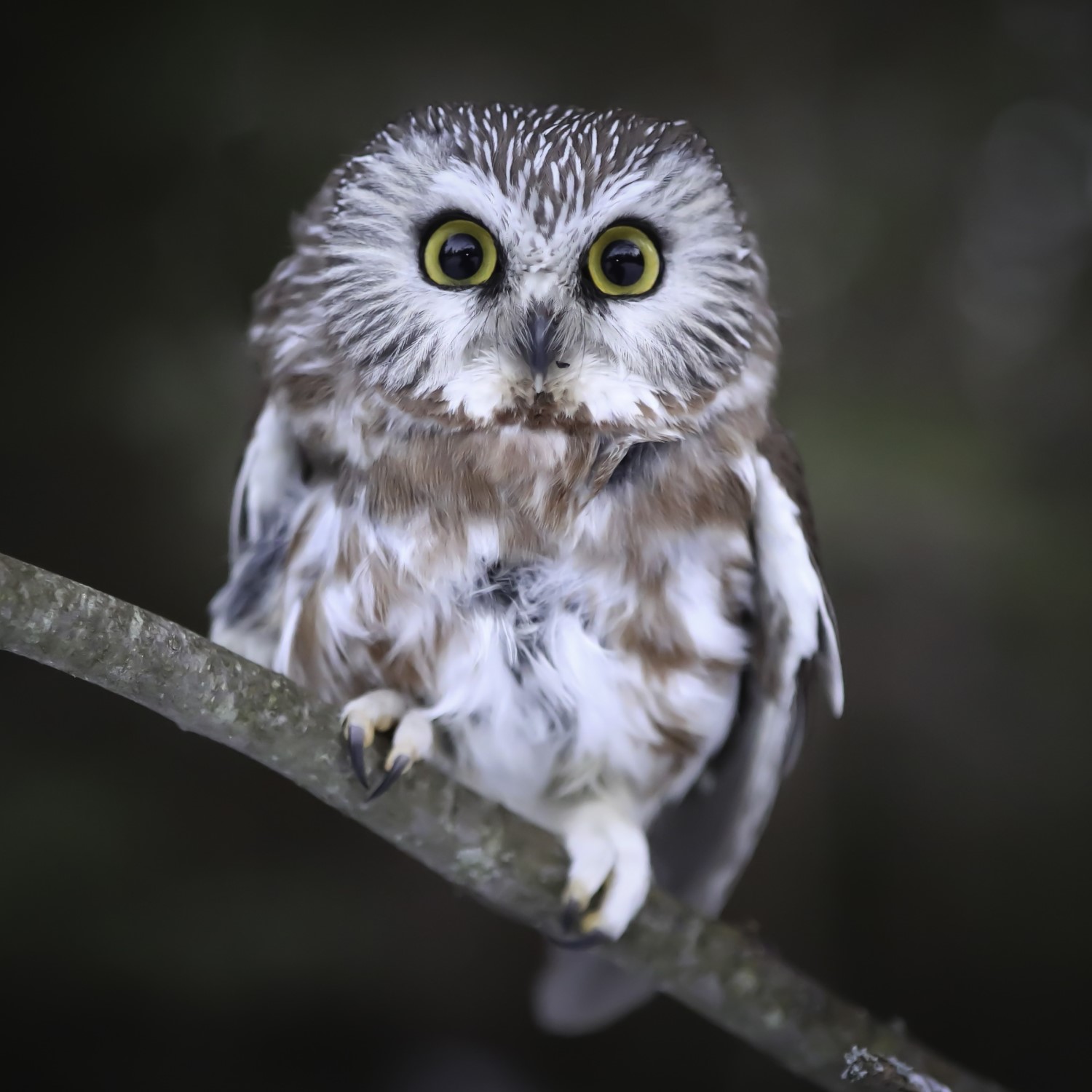
Northern Saw-whet Owl
Aegolius acadicus
Order: Strigiformes
Family: Strigidae
Size: 8-8.5 in. (20.3-21.5 cm)
Overview
These owls are short and compact. At just 8 inches in length and with a wingspan of 22 inches, northern saw-whet owls are among the smallest owls in the United States. Northern saw-whet owls like to prey on deer mice, using their sharp beaks to tear their prey into smaller pieces, breaking up a single mouse into several meals. Because these owls are nocturnal, and because they’re so small, they can be difficult to track. But their sharp cries make it easier to locate them in their forest homes. Northern saw-whet owls are mostly solitary creatures, only socializing with their mates. Females have been known to have two mates, leaving the first to raise a brood with the second. These owls have porphyrin pigments in their feathers, and when illuminated with a UV light, the ventral side of the wings shows a neon pink color. This helps researchers determine an owl’s age.
How to Identify
Named because its call sounds like a saw being sharpened on a whetstone, saw-whet owls have small heads and cat-like faces with relatively large yellow eyes. With rust-colored backs, breasts, and wings, northern saw-whet owls have spotted heads and distinctive Y-shaped markings on their faces. These owls use a variety of vocalizations to communicate. They’re most easily identified by their shrill “too-too-too” calls, which they use to attract mates. The cries of northern saw-whet owls are so loud that they can be heard nearly 1,000 feet away.
Northern Saw-whet Owl Range & Migration Map
One of the most common owls in the U.S., the northern saw-whet prefers to dwell in mountain forests. They can be found year-round in California, New Mexico, Utah, and Colorado, and in the northeastern states, Minnesota, Wisconsin, Michigan, New York, and all the way through to Maine. These owls can be seen in other territories, too, during non-breeding times. It’s not unheard of to see northern saw-whet owls throughout the midwest, including Kansas, Missouri, and Illinois.
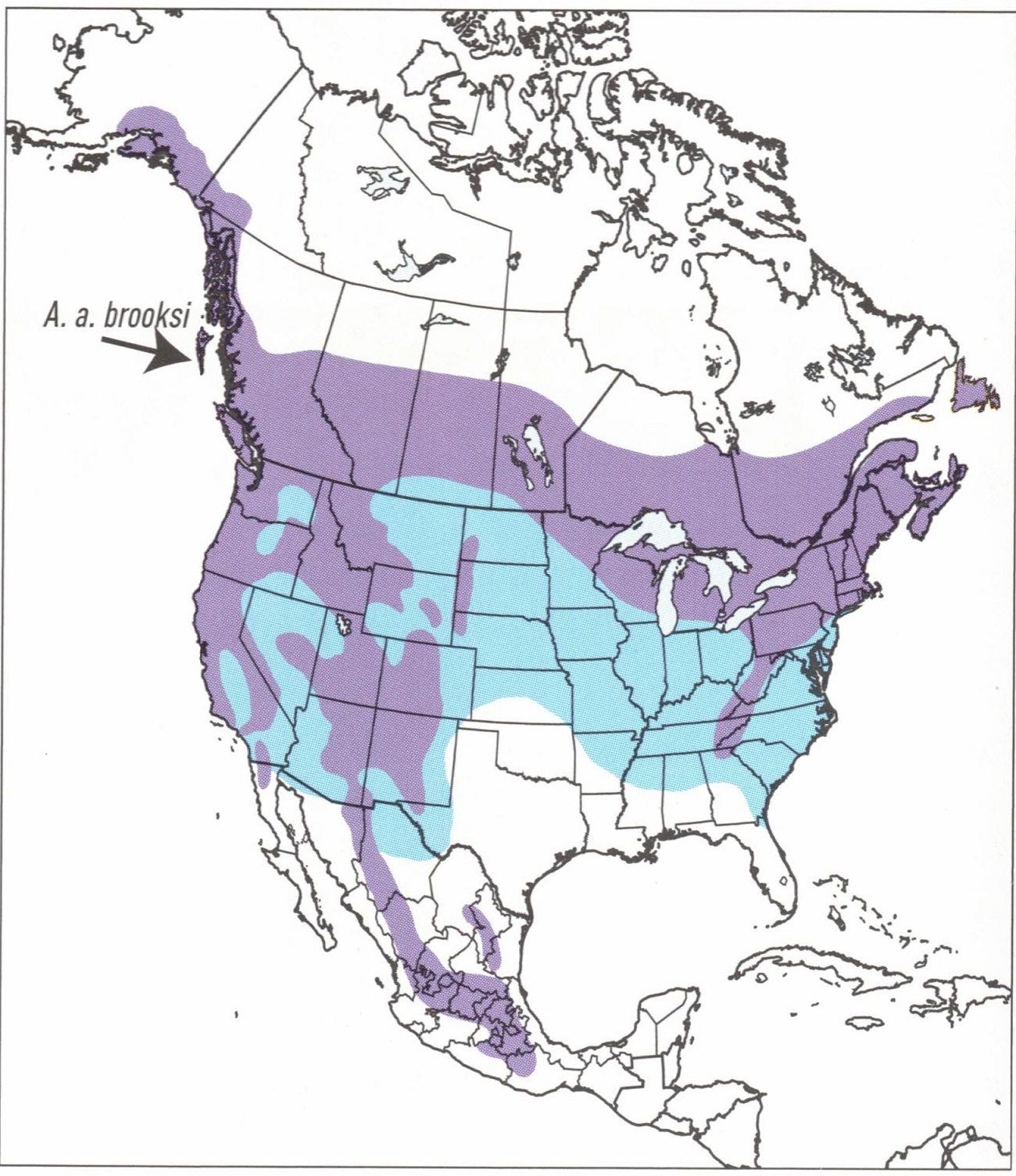
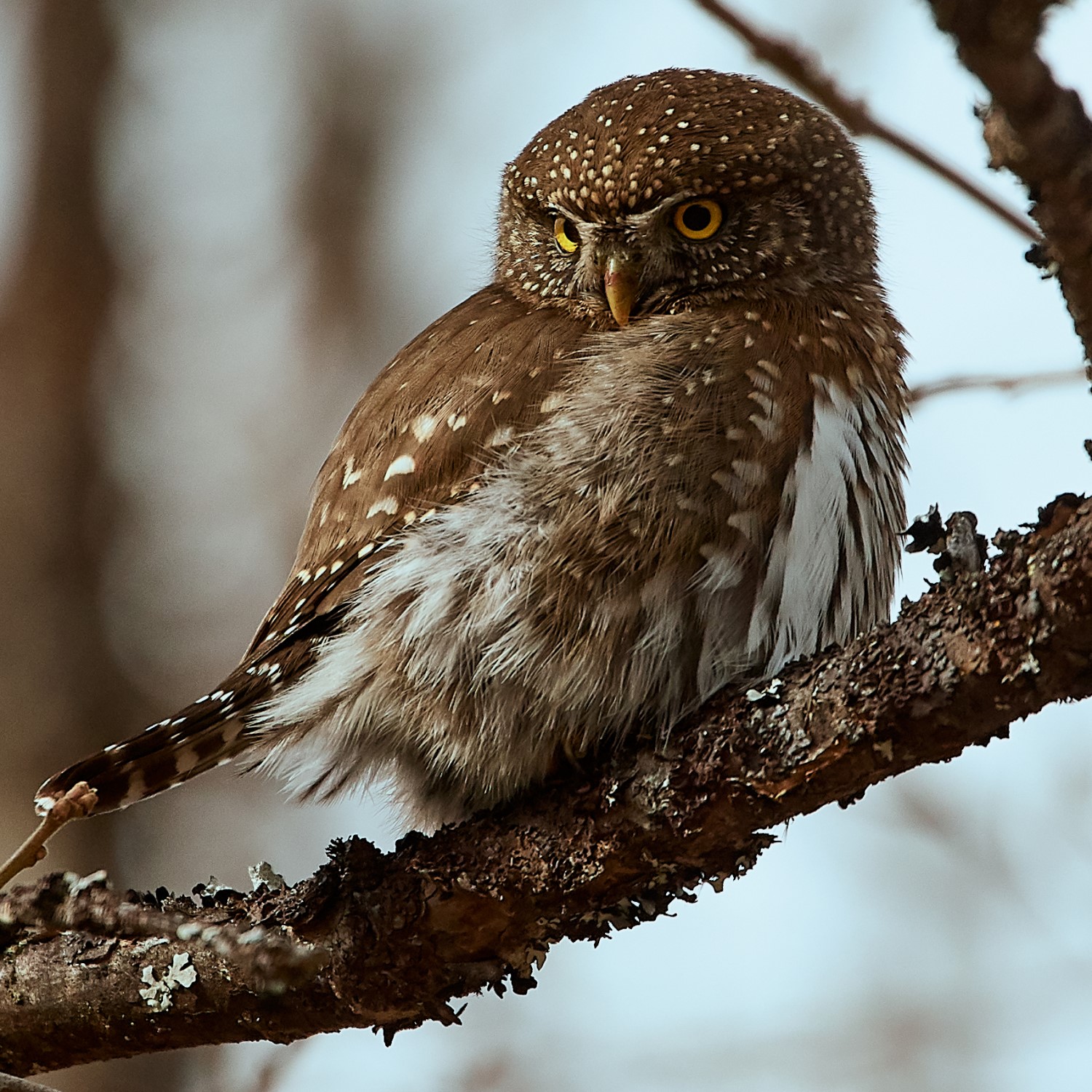
Northern Pygmy-Owl
Glaucidium gnoma
Order: Strigiformes
Family: Strigidae
Size: 6.5-7.3 in (16.5-18.5 cm)
Overview
These owls are a favorite among birdwatchers because they prefer to hunt during the daytime. This, coupled with their courageous nature, makes them easier to spot compared to more skittish members of the species. Northern pygmy owls are generally unafraid of humans, and will happily nest in urban areas. This is likely due to the fact that humans set up bird feeders to attract songbirds — the northern pygmy owl’s favorite food. These owls ambush their prey and store their leftovers on thorns and spikes to come back to later. Northern pygmy owls are such a threat to smaller birds that wrens, jays, and even hummingbirds will mob them to chase them away. Though these birds are only about as long as a butterknife, they’ve been known to attack prey much larger than themselves, including chickens. Because northern pygmy owls lack the substantive facial disks needed to improve hearing, they rely on their keen eyesight to track their prey.
How to Identify
At just 7 inches long, northern pygmy owls are quite small, but don’t let their size fool you. These are tough, tenacious little birds! Adults are gray, brown, or red-brown in color with white spotted heads and dark wings, tails, and breasts. Like ferruginous pygmy owls, northern pygmy owls have dark spots on the backs of their heads that look like another set of eyes. This helps to confuse both prey and predators. The best way to find a northern pygmy owl is to track its high-pitched tooting calls.
Northern Pygmy-Owl Range & Migration Map
These owls are somewhat adaptable, moving into cityscapes as their native mountain forests become less available. Unfortunately, however, these owls don’t often make their homes in nesting boxes, so these are an ineffective means of attracting them. You can find northern pygmy owls throughout the western states, in California, Oregon, and Idaho, and farther south in Colorado, Arizona, and New Mexico.
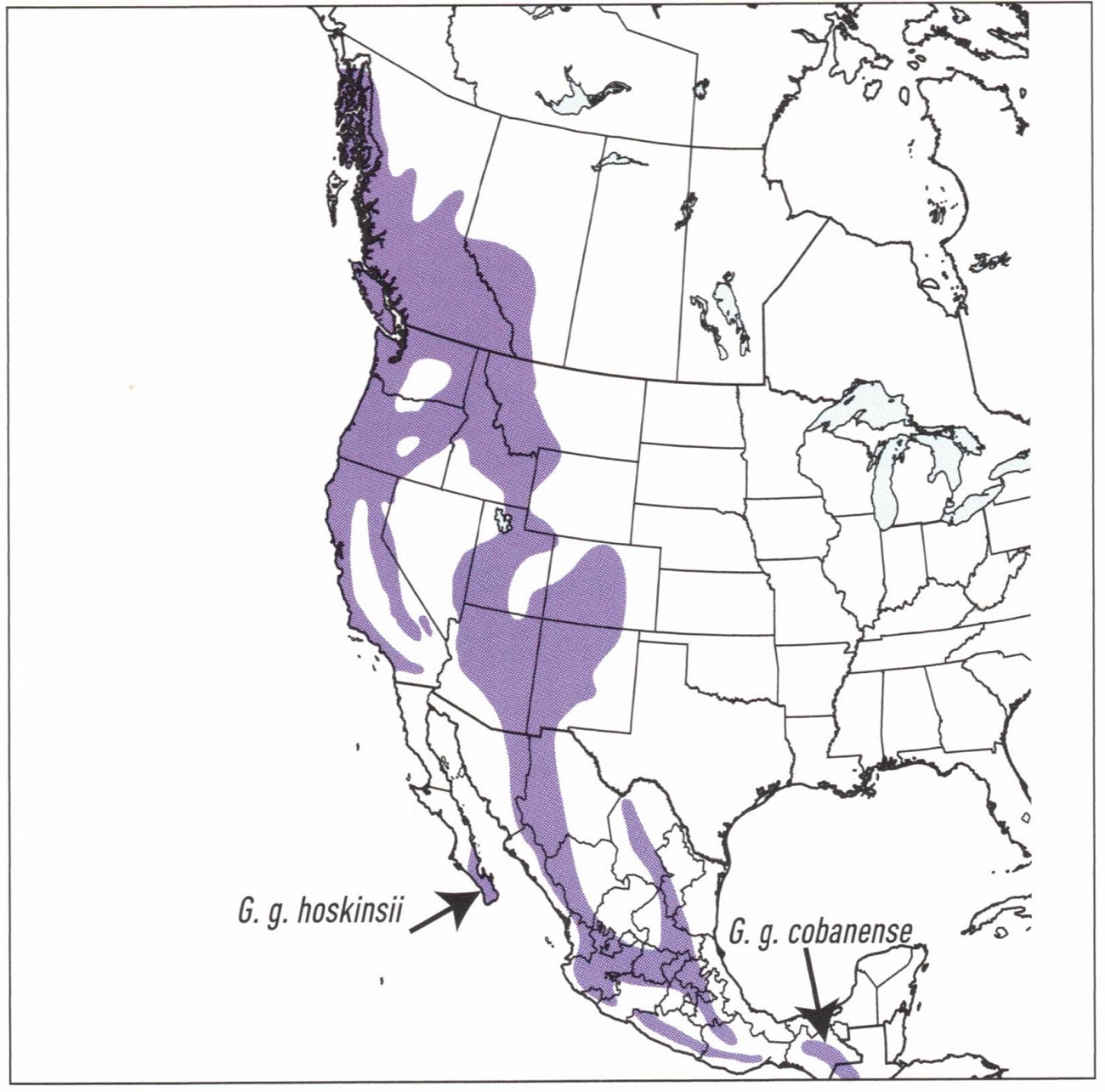
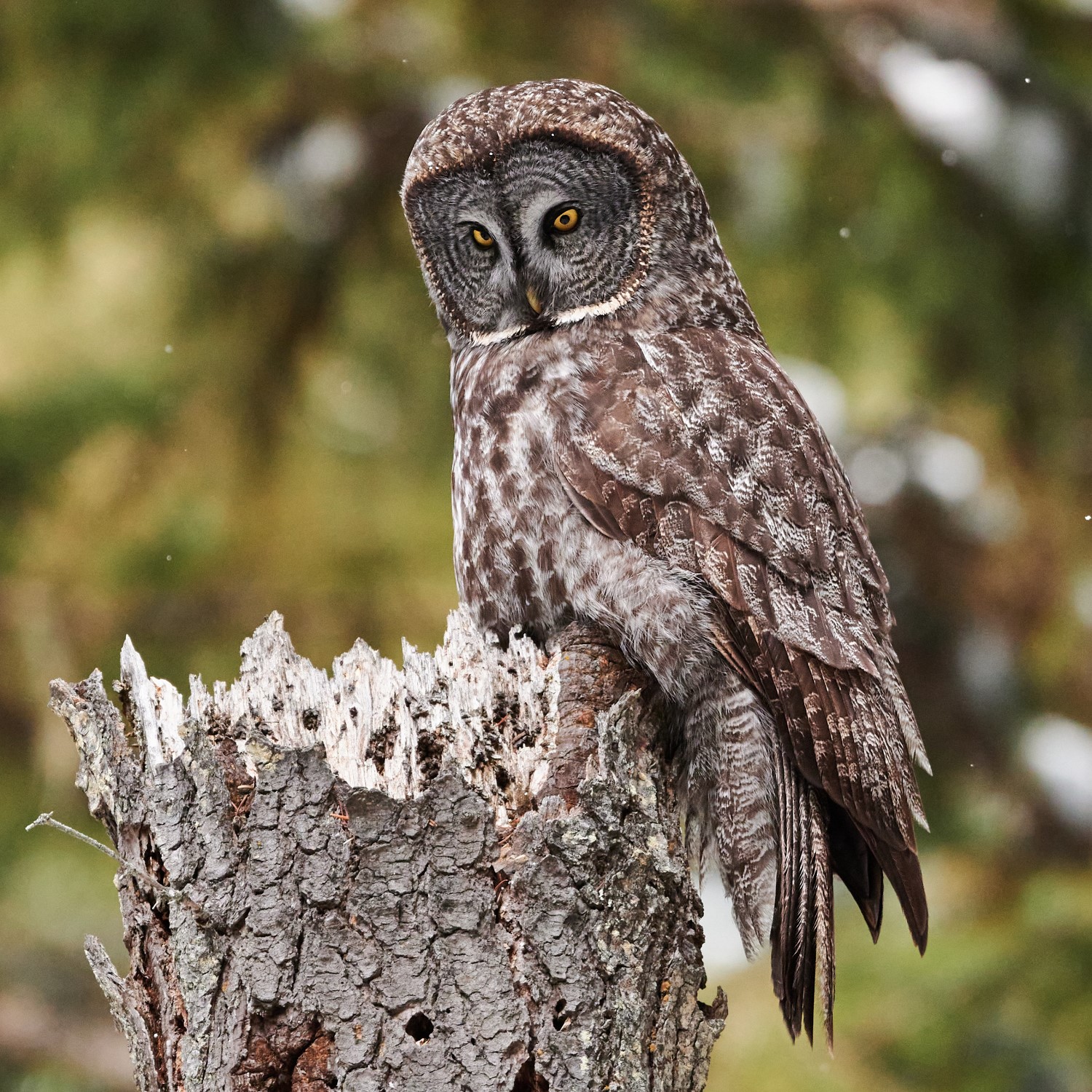
Great Gray Owl
Strix nebulosa
Order: Strigiformes
Family: Strigidae
Size: 25-33 in. (63.5-84 cm)
Overview
At 33-inches long, great gray owls are the largest species of owl in the world in terms of length, with females being slightly larger than males. These birds have an impressive wingspan averaging around 5 feet. But, even though this owl looks quite large, it actually isn’t that big — it’s mostly feathers. Unlike great horned owls, which can weigh up to 5.5 pounds, great gray owls are padded out with dense plumage and weigh just 3.75 pounds. Their light weight allows them to fly quietly as they scour the forest floor in search of food. Their asymmetrical ear openings enable them to track their prey while their powerful feet and talons can clear through densely-packed snow to capture rodents and small mammals tunneling beneath it.
How to Identify
With its gray feathers and haunting expression, the great gray owl has also been dubbed the Phantom of the North. This steel to brown-gray owl has a sooty appearance with amber yellow eyes and large disks surrounding them, giving them an appropriately wise expression. Just beneath the bird’s beak lies a white “bowtie” that tapers to rounded ends. The great gray owl uses deep, rhythmic “whoo-whoos” to guard its territories and communicate with its family.
Great Gray Owl Range & Migration Map
Great gray owls can be found year-round in boreal forests in the northernmost states. Look for these beautiful birds of prey in Minnesota, Michigan, Wisconsin, and New York. You’re also likely to spot them in California, Oregon, Idaho, and even parts of Wyoming and Utah.
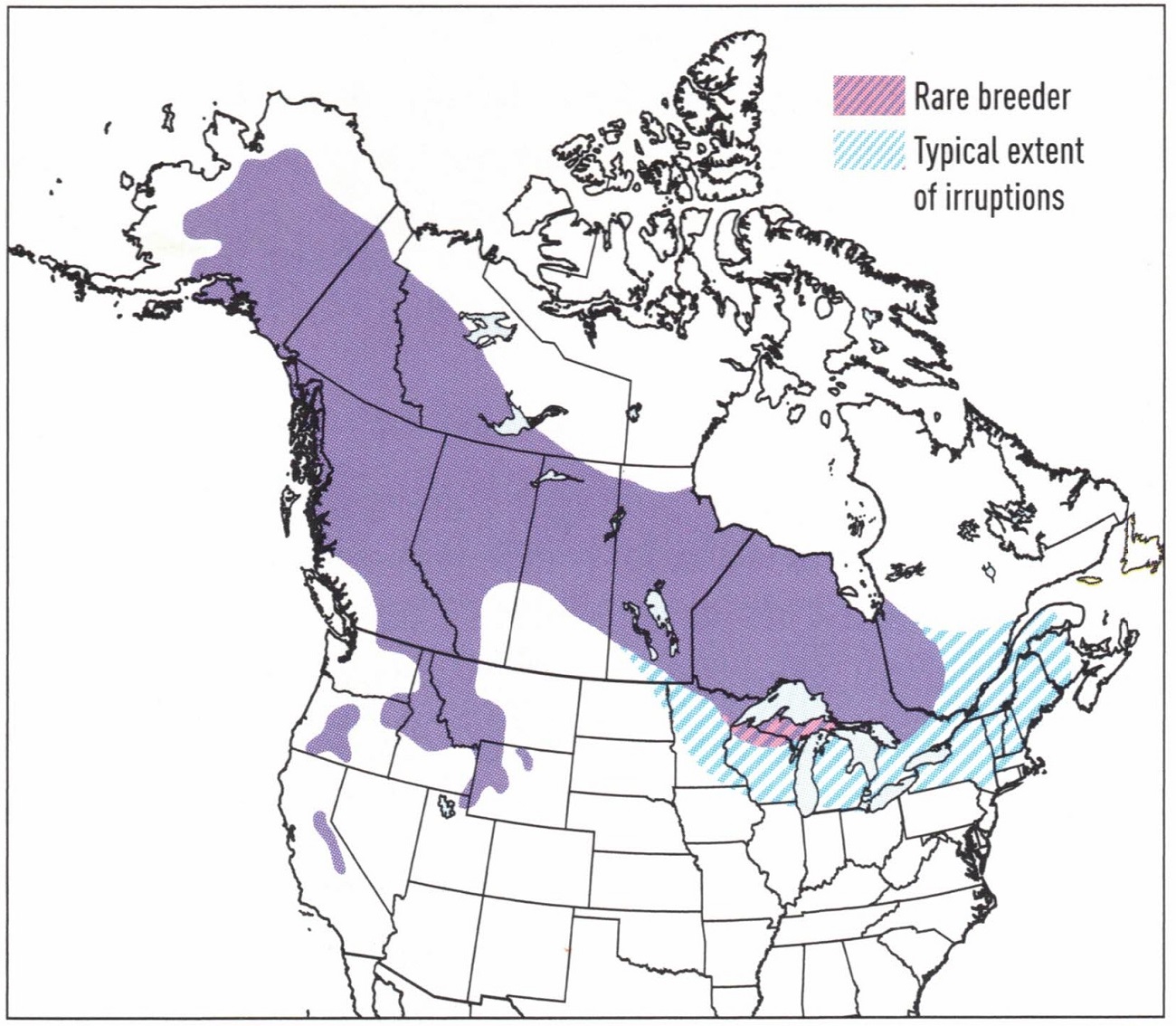
How to Attract Alaska Owls to Your Backyard
While some owls, like the boreal owl and the whiskered screech-owl, avoid humans and can be tough to find, other owls, like the barred owl and eastern and western screech-owls, are much easier to attract.
Install nesting boxes on trees, poles, and fences to encourage your neighborhood owls to take up residence on your property. Leaving brush, wood piles, and old lawn trimmings provides homes for voles, field mice, rabbits, gophers, and snakes. Having plenty of these critters nearby is a surefire way to get your local owls’ attention.
Because many owls like to feed on songbirds and squirrels, setting up a bird feeder and getting a bird bath can also encourage owls to pay you a visit. Of course, some birds work to scare owls off. Jays, crows, blackbirds, grackles, and starlings regularly mob owls, so take measures to scare these birds away — take down starling nesting boxes, and remove cracked corn and peanuts from your feeders, which are the preferred foods of these birds.
Owls love to sit on poles and in leafless trees because they make it easier for them to spot prey. Make sure your owls have plenty of spots to perch on. You can also attract these birds by limiting your outdoor activity, especially in the early morning and late evening hours when they like to hunt. Together, all of these measures will help your neighborhood owls feel right at home in your backyard.
All State Owls
Want to see what owl species are found in other states? Here’s our complete list of owls found in each state:
